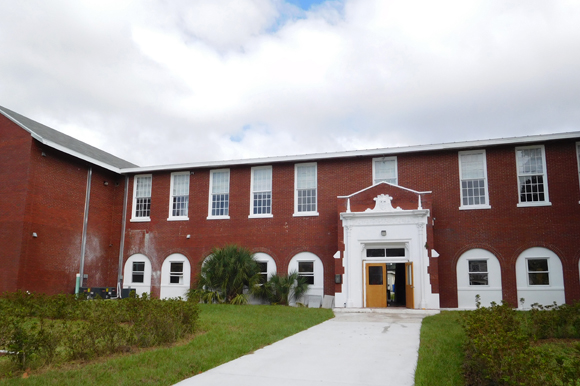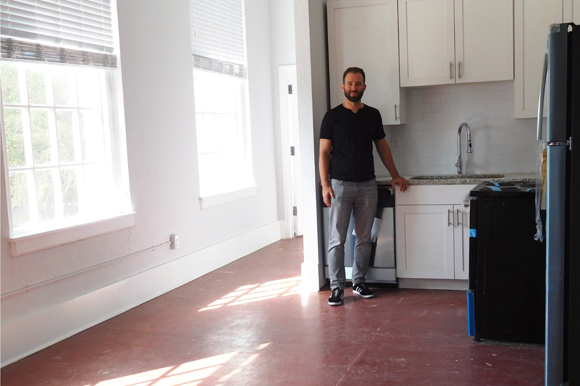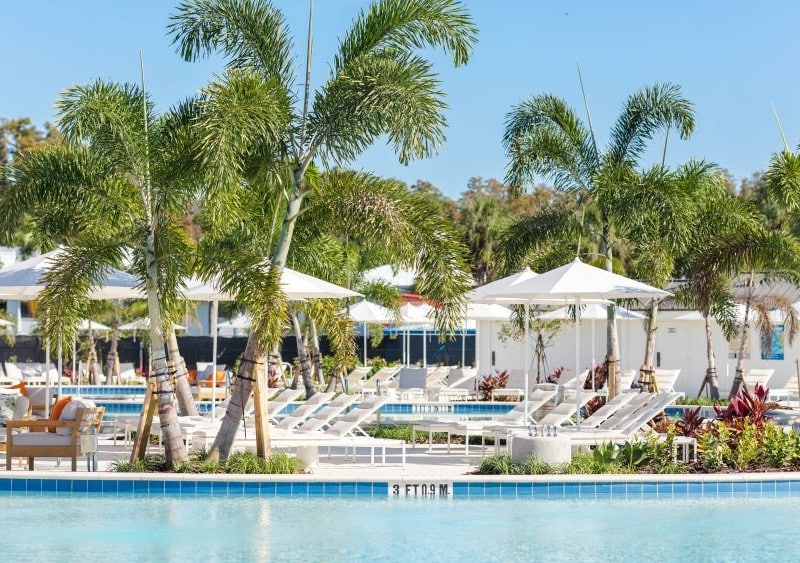Reuse, rebuild, repurpose: St. Pete historic buildings get new leases on life
1920-era buildings in St. Pete like the Euclid School and Uptown Historic Flats have been transformed into cool apartment buildings. Quirky pockets of the city like Al Lang Court are getting historic designation.
Gargoyles look down from their lofty perch above the enormous front door of the red brick Euclid Elementary School. Built in 1924, long before air conditioning, you can still see the outline of tall archways that led to a breezeway. Beautiful mosaic tiles were once the backdrop for water fountains.
Inside, there are thick textured stucco walls and an old-fashioned black banister leading to the second floor.
The historic school in St. Petersburg’s Euclid-St. Paul neighborhood caught the eye of developer Michael Mincberg, a University of South Florida Tampa graduate who is president of Sight Real Estate.
The building was in bad shape. Ugly blue carpeting covered the wood floors, says Mincberg. The wooden frames on the enormous old-fashioned windows were rotted.
Mincberg bought the building anyway. But rather than tearing it down and building something new and modern, he and one of his investors, Matt Joyce, a Tampa native and outfielder for the Oakland Athletics, saw the school’s potential.
Now, in place of classrooms, there are 16 one- and two-bedroom apartments on two floors. The amenities are modern — granite countertops, stainless appliances and solid wood cabinets in the kitchen. But the historic touches are everywhere.
Craftsmen re-did the thick interior stucco walls. They polished the concrete floors, preserved the mosaic tiles and fixed up the schoolhouse windows that are in each apartment. Apartment ceilings are at least 12 feet tall, which makes the rooms spacious.
“There were over 100 windows and it took us forever to furbish them,” says Mincberg.
There are other fun touches that reflect on the building’s heritage, like the exterior apartment doors that have a special chalkboard paint for writing messages.
A photo display of students from back in the day will hang on the wall when you enter the building. The old school bell and a firm alarm box have been preserved. Mincberg also plans to include a lending library and school lockers on the 2nd floor for homeowners to use.
“There is so much character in the building,” says Mincberg. “I wanted to keep all of the elements that make it look like a school. A certain kind of tenant appreciates a building like this. I think the people who live here will feel the energy.”
Preserving a piece of history
“Michael is one of the developers who gets it,” says Peter Belmont, VP of the St. Petersburg Preservation Society.
“St. Pete is a special place and one of the things the Preservation Society does is to try to keep it special,” says Belmont. “What that means is keeping the sense of place that makes us different from so much of Florida where everything looks the same.”
“There is so much commoditized housing already,” says Mincberg. “I like developing something different. I don’t go after properties because they’re historic necessarily, but because they have character. I love seeing urban neighborhoods get a second life.”
Mincberg collaborated with the St. Petersburg Preservation Society to apply for local historical designation for the Euclid School. He credits the St. Petersburg Preservation Society for making it happen.
“They are very organized, effective and committed,” he says.
On Thursday, Nov. 9, the St. Petersburg Preservation Society will celebrate the completion of the Euclid School renovation with a porch party from 6 pm to 8 pm. The cost is $10 for members and $20 for non-members. In addition to tours, St. Petersburg residents who attended the school will be part of an open discussion.
“We are thrilled to have been able to contribute to the restoration and preservation of the Euclid School House,” Allison Stribling, the executive director for St. Petersburg Preservation Society, said in a press statement. “It is a great piece of St. Pete’s history.”
The Euclid school is not the only historic property Mincberg has invested in.
Additional Sight Real Estate projects include three apartment buildings from the 1920s that were once rooming houses catering to St. Petersburg’s influx of winter visitors when the city was a big tourist destination.
Located near Mirror Lake and the historic St. Pete Shuffleboard Court, the project, called Uptown Historic Flats, retains the exterior Mediterranean architectural style popular in that era. The interior apartments are updated and modern.
Two of the buildings are completed and 100 percent occupied, says Mincberg. Work continues on the third. Although it’s taken a lot to bring the buildings up to code, Mincberg says it’s a project he enjoys. “St. Petersburg has dozens of these old 1920-era seasonal tourist apartments,” says Mincberg. “I wish I could get all of them.”
He’s also working on restoration of an apartment building from the 1920s in St. Pete’s up-and-coming Warehouse Arts District.
The 1920 wood frame original building housed industrial workers migrating to the city and was in “horrible shape,” says Mincberg. Now it’s being repurposed into a 10-unit “creative space” zoned for artists looking for a live, work and play set up.
“People want to live in these apartment buildings now for the same reason they wanted to live in them back in the 1920s,” says Mincberg. “They want to be central to everything and not have to rely on a car to get around. They like the idea of living close to downtown.”
Neighborhood designations
St. Petersburg has an extensive list of buildings from the 20s that have been designated as local historical landmarks. The St. Petersburg Coliseum, Princess Martha Hotel, Flori-de-Leon Apartments and original St. Petersburg High School at Mirror Lake are good examples.
More recently, the 1924 Cade Allen residence in the city’s Allendale Neighborhood and Lang’s Bungalow Court also received designation.
Located off of 4th Avenue North, just south of 9th Street North and Interstate 375, Lang’s Bungalow Court is a tiny collection of bungalow homes established in 1915 by St. Petersburg’s former mayor Al Lang. It’s a quaint hidden gem with a hexagonal brick pedestrian pathway running down the center of the street — no cars allowed.
To preserve the integrity of the area, residents turned to the St. Petersburg Preservation Society for help in applying for local historical designation status.
“Over the past few years, our focus has been more on preserving neighborhoods as opposed to individual buildings,” says Belmont. “It’s difficult to designate an entire neighborhood as an historical district, but we’ve been helping get small blocks within the neighborhood get approved.”
The St. Petersburg Preservation Society is currently working with homeowners on designation of select section of the old Northeast and Kenwood.
“It’s all about protecting a neighborhood’s character and what keeps it special,” says Belmont. “Historical district designation doesn’t dictate what should or should not be there. It encourages buildings to be restored, not to be demolished and calls for a review of new construction or significant reconstruction to make sure it is in keeping with adjacent homes.”
To suggest additional story ideas, email 83 Degrees.
To subscribe to our free weekly e-magazine, follow this link.

















